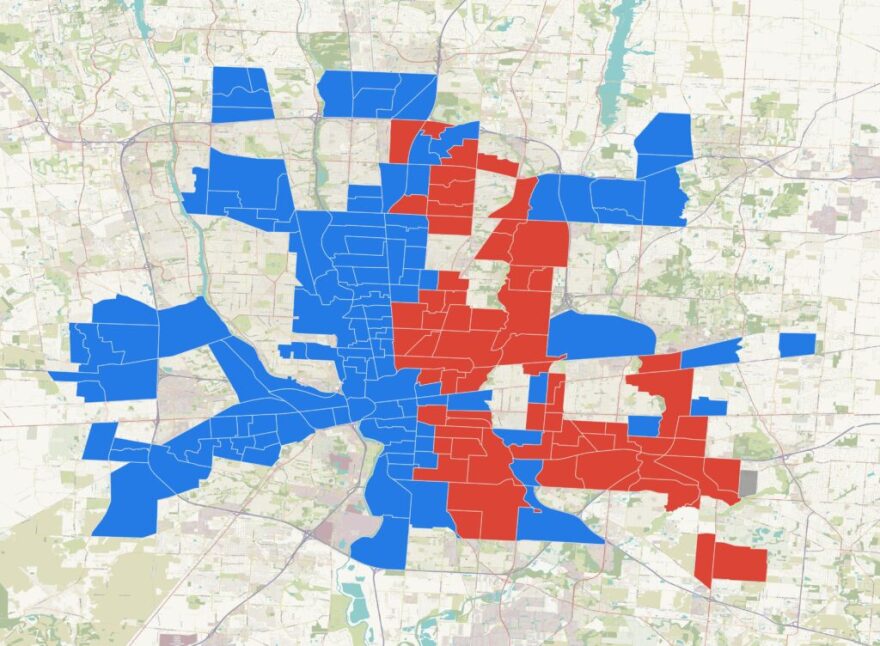Tuesday's primary election results show one candidate for Columbus City Council took home more support from precincts covering the city's 7th district, but also a split for candidate support along historic lines of racial segregation.
When you look at a map of Tuesday’s unofficial election results available from the Franklin County Board of Elections, two things stand out.
First, the core of downtown Columbus and its surrounding neighborhoods are mostly a bright turquoise showing where Jesse Vogel received the most votes. Much of the rest of the city is a dark purple which represents where Tiara Ross won. The central area where Vogel won is District 7.
Second, there is a clear east-west divide between where Vogel won support and Ross won support. That divide closely follows historic lines that were used to segregate residents based on race. The impact of this "redlining" has persisted through today.
Vogel has more votes in precincts covering District 7 council seat.
District 7 is the open seat Ross, Vogel and Kate Curry-Da-Souza ran for. Curry-Da-Souza was eliminated in the primary. Ross and Vogel will face each other in the November general election.
Columbus’ district system requires the candidates to live in one of the nine districts. Unlike other cities with districts, or wards like Cleveland, the entire city voted in the race and not just the residents of that district.

Elizabeth Grieser, with the League of Women Voters, first spoke to WOSU about the district system when it went into effect two years ago.
At the time, she said the organization wasn’t for or against the system. She said Tuesday’s election raised concerns, but their position hasn’t changed.
"This is a bit of an experiment. We just voted on this back in 2018," Grieser said. "So, after we give it some time and we may decide... there might be a lot of down sides to this. We could potentially go back to the voters."
Grieser said the group also sees the potential for positives for the city, like forcing elected officials to become more familiar with the neighborhoods they represent.
Grieser also said it is clear from the election map that if only District 7 residents were allowed to vote in the race, Vogel would have been the clear winner. Instead, Ross’ support from outside District 7 earned her a narrow win over Vogel.
Vogel told WOSU on Wednesday he is honored by the support he received from resident in District 7. He said if there was a true ward system, he would have won.
Vogel said he is prepared for a city-wide election.
"Folks in Columbus want to see representation that reflects their values and choice for the future. We're prepared for the challenge to run city wide because that is what it takes to win," Vogel said.
Ross did not take questions on the topic. Her campaign referred WOSU to her campaign night press release.
“I want to thank every volunteer, supporter, and neighbor who believed in this campaign and the vision we shared for a more just and inclusive Columbus. I am deeply honored by the trust and support our community has shown,” Ross said in a statement. “In every corner of Columbus, people opened their doors and shared their hopes for a safer, more affordable, and more just Columbus. Tonight, they made it clear they believe in what we’re building—and we’re going all the way to November.”
Impacts of racial redlining persist in Columbus, showing divide in City Council race.
The other trend the map showed was a clear split between the east and west side of the city along I-71.
Columbus was racially segregated along I-71 in the 20th century with white people to the west in neighborhoods like Clintonville and minorities to the east in places like Linden.
Vogel, a white man, took most of the western vote, while Ross, a Black woman, won support from the east.
Michael Wilkos, with the United Way of Central Ohio, studies redlining. He said the practice used highways and railroads to bulldoze minority neighborhoods across the United States and create barriers with white neighborhoods.
U.S. Census data for Columbus shows the election results for Vogel and Ross align closely with where Black people and white people live.

Wilkos said he was surprised to see the impacts of redlining are persisting so much that it is effecting city elections decades later in 2025.
“Neither of these candidates ever spoke about race. They never talked about race," Wilkos said. "But look what happened. There was a clear pattern that follows the pattern of every single map I can show you.”
Columbus City Council President Shannon Hardin did make his wishes known for a Black woman to win the seat. But Wilkos is right that racial politics weren’t a hot topic of the candidates' campaigns.
Wilkos said in his studies and research, maps showing things like food insecurity or evictions often align with how a city was racially segregated.
"Even in a campaign that has nothing to do with race, these patterns are still very clear. That railroad track that runs from downtown Columbus up to Ikea, that railroad track that hugs Interstate 71. That has been a race demarcation line for a very, very long time, and it is holding," Wilkos said.
Wilkos said this shows every American city is still dealing with the effects of policies meant to separate residents based on race.
Vogel said he got diverse support from his voter base, but he still wants to broaden and grow support, especially in Black communities.
"I look at that map and I see that color line, but I know that as you dig into each precinct looking at majority-Black precincts, it is clear to me that we held our own," Vogel said.
Higher voter turnout in November could impact where candidates draw support
Grieser said there is an expectation that November's voter turnout will be higher than what she called a "horrendous" showing on Tuesday. Voter turnout in Columbus was around 8% this year and 10% in Franklin County.
Grieser said she thinks the ward system may have blunted turnout by confusing some voters.
“I think that is a talking point that really needs to be elevated more, so that more people are aware that anyone in the city of Columbus can vote for any district representative in Columbus City Council," Grieser said.
She didn’t say whether higher turnout may have changed the results much. But she expects at least double the turnout in November.
Wilkos said he doesn’t think higher turnout will change what the map shows when it comes to racial segregation.


